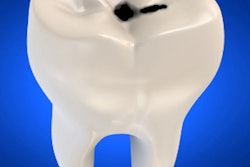
To combat early childhood caries, the California Department of Health Care Services (DHCS) has approved the use of silver diamine fluoride (SDF) for some high-risk children enrolled in Denti-Cal, the state's dental Medicaid program.
The change was announced at a January 24 webinar that further detailed the multimillion dollar plan to overhaul Denti-Cal. The department also unveiled its caries-risk assessment form and announced a training partnership with the California Dental Association.
"The cost of caring for a child with extensive caries is expensive," said Jayanth Kumar, DDS, MPH, California's state dental director. "Many children in Medicaid do not receive adequate preventive services."
Strategies to prevent childhood caries
Early childhood caries is an acute problem for California's kids. By the time a child in the state reaches kindergarten, he or she has a 5 in 10 chance of experiencing decay, according to Dr. Kumar. California's answer to its caries problem is a $740 million, five-year plan called the Dental Transformation Initiative (DTI).
The webinar focused on a pilot project on caries risk assessment and disease management that has the goal of increasing preventive services for children ages 6 and younger who are enrolled in Denti-Cal. To accomplish that, DHCS created its own caries risk assessment tool.
Using a simple yes or no checkbox system, the assessment asks about patients' biological and behavioral risk factors and disease indicators, including the following:
- Sleeping with a bottle containing a liquid other than water
- Frequently or regularly using an asthma inhaler
- Having obvious decay
"We use a very simple approach," Dr. Kumar said. "If there are clinical manifestations of the disease, then those children are considered high-risk."
Dental professionals who enroll in the pilot program and complete a two-hour training course from the California Dental Association will be reimbursed $15 for each risk assessment, as well as $46 for nutritional counseling and $65 for motivational interviewing related to the assessment.
The caries risk assessment form can be submitted electronically or by paper, and the reimbursement schedule will be based on a child's risk status:
- Low-risk children will be eligible for preventive services and risk assessment twice per year.
- Moderate-risk children will be eligible for preventive services and risk assessment three times per year.
- High-risk children will be eligible for preventive services and risk assessment four times per year.
Providers enrolled in the pilot project can also be reimbursed $35 per patient for using silver diamine fluoride on high-risk children. SDF has been shown to halt caries development in primary teeth.
"We want to encourage the use of silver diamine fluoride to arrest dental caries," Dr. Kumar said.
Only a pilot program
It is important to remember that the changes are part of a pilot program, so only dentists in 11 eligible counties will be able to opt in to the pilot. None of the eligible counties include California's three major cities: San Diego, Los Angeles, and San Francisco. In addition, the pilot program did not change what some have said are low reimbursement rates for caries treatment.
Some dentists are also concerned that the caries risk assessment form is only in English. A DHCS official said that there are plans to get the form in other languages, but did not provide a target date during the webinar.
As outlined in the Dental Transformation Initiative plan, the Department of Health Care Services will monitor what effect the new pilot program has on early childhood caries over the next several years. The department will also provide updates at regular intervals.
"There is a paradigm shift in how caries is managed these days. Surgical management doesn't address the underlying causes," Dr. Kumar said. "This approach aligns with the transformational changes occurring in the healthcare sector."



















